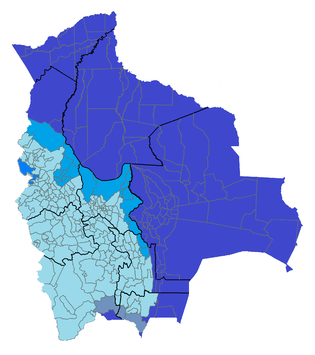Bolivian Spanish
The Spanish (or Castilian) language is spoken in Bolivia by most of the population, either as a mother tongue or as a second language. Within the Spanish of Bolivia there are different regional varieties. In the border areas, Bolivia shares dialectal features with the neighboring countries.
| Bolivian Spanish | |
|---|---|
| Español boliviano | |
| Native to | Bolivia |
Native speakers | 4,1 million (2014)[1] 4,5 million in Bolivia (2014) |
Indo-European
| |
| Latin (Spanish alphabet) | |
| Official status | |
Official language in | |
| Regulated by | Academia Boliviana de la Lengua |
| Language codes | |
| ISO 639-1 | es |
| ISO 639-2 | spa[2] |
| ISO 639-3 | – |
| Glottolog | None |
| IETF | es-BO |
Throughout Bolivia the preservation of phonemic contrast between /ʝ/ and the lateral /ʎ/ (i.e. the absence of yeísmo) is the norm.[3][4] Aspiration of syllable-final /s/ is frequent in the lowlands, while in the highlands the sibilant /s/ tends to be preserved, realized either as a laminal or, frequently, an apical [s].[4][5] In highland dialects, the "trill" phoneme (orthographic Template:Graphreme or word-initial ⟨r⟩) is often assibilated, realized as a voiced apicoalveolar fricative,[5][6] or alveolar approximant, which pronunciation is similar to the sound of ⟨r⟩ ([ɹ]) in English. In highland Bolivian Spanish there is "intense reduction" of unstressed vowels in contact with /s/, often resulting in syllables with /s/ as their nucleus, e.g. pues ("well,...") pronounced [ps].[4][7]
Dialects of Spanish in Bolivia

Andean Spanish
Camba Spanish
This variety of Spanish is spoken on the Chaco-Beni plain and in the Santa Cruz valleys, a region that includes the departments of Santa Cruz, Beni, and Pando.[8] Spanish is spoken by almost the entire population of these regions, and—like Spanish throughout the Americas—has its basis in Andalusian Spanish, but with influences of native languages such as Chiquitano, Chané and Guarani, as well as Old World languages including Portuguese and Arabic.[8] And although it is fairly uniform across regions and social classes, there are subtle geographical differences.
This dialect is characterized by the debuccalization ("aspiration") of final /s/. For example, the word pues is pronounced [pweh]. For the second-person-singular pronoun and verb forms, the use of "voseo" is dominant. The use of diminutive ‑ingo and the augmentative ‑ango is unique to this dialect. For example: chiquitingo ("very small") and grandango ("very large").
Loanwords from Chiquitano or from an extinct variety close to Chiquitano include bi ‘genipa’, masi ‘squirrel’, peni ‘lizard’, peta ‘turtle, tortoise’, jachi ‘chicha leftover’, jichi ‘worm; jichi spirit’, among many others.[9]
Chapaco Spanish
This dialect is spoken mainly in the valleys and the Gran Chaco of the department of Tarija, but also in the region of Villa Abecia and Camargo (in the department of Chuquisaca), in the province of Sud Chichas (capital Tupiza), and in the Chaco regions of Chuquisaca and Santa Cruz. The second-person-singular voseo is in full use in Tupiza, in the west of Tarija, and in the rest of the aforementioned areas. The Chapaco accent has an intonation similar to that of Jujuy, Salta, and Tucumán in Argentina, as the territory where it was spoken before was the Río de la Plata Province of Tarija. It has similar intonation throughout the Bolivian Chaco, Tupiza (Sud Chichas) and the Chuquisaca valleys of Camargo, Villa Abecia, Azurduy, Alcalá, etc.
Valluno Spanish
This variety is spoken in the departments of Cochabamba and Chuquisaca. It is somewhat similar to Andean Spanish but differs in intonation and the use of idiomatic expressions, due to the mixture of Spanish and Quechua spoken in the valleys of Bolivia.
Vallegrandino Spanish
Note
Because many institutions and companies use "tú" and the "tuteante" verb forms for the familiar second-person singular, it is common to encounter the erroneous statement that "tuteo" rather than "voseo" is the usual form in the speech of Bolivia.
References
- Spanish → Bolivia at Ethnologue (18th ed., 2015)
- "ISO 639-2 Language Code search". Library of Congress. Retrieved 21 September 2017.
- Canfield 1981:28
- Lipski 1994:188
- Canfield 1981:29
- Lipski 1994:189
- Canfield 1981:29–30
- Coimbra Sanz
- Nikulin, Andrey (2019). "Contacto de lenguas en la Chiquitanía". Revista Brasileira de Línguas Indígenas. 2 (2): 5–30.
Bibliography
- Canfield, D. Lincoln (1981), Spanish Pronunciation in the Americas, Chicago: University of Chicago Press
- Coimbra Sanz, Germán (1992), El castellano de Santa Cruz, Santa Cruz de la Sierra, Bolivia: Parva Editores
- Lipski, John M. (1994), Latin American Spanish, London: Longman